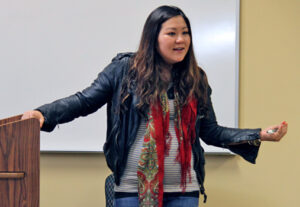arts based methods
Select an item by clicking its checkbox
(Part Three of a Five Part Serialized Blog) Pivots or shifts in our thinking away from western and colonially oriented epistemologies are hard. The academy is a colonial entity. It is invested in colonizing us, thoroughly and into generations; colonization of thought processes and embodiments, the way we collect knowledge, ...
During the past year and a half of the pandemic, the uprisings for racial justice, the continued fight for LGBTQIATS justice, the struggle for the rights of immigrants, and the global impact of climate change, I discovered an urgency in myself to create and to grow things as a way ...

Lifelong Learning, The Arts and Community Cultural Engagement In The Contemporary University: International Perspectives
Date Reviewed: August 14, 2015
How might arts-based teaching, learning, and research transform education? This question is explored by demonstrating that arts-based methods and aesthetic pedagogies critically and creatively communicate, teach, make meaning, uncover, and involve students in learning activities. While prevailing attention in the academy is placed on science, math, business, and technology, the collective aim of this volume is to highlight the imaginative practices and creative voices that address the potentials, tensions, and challenges that educators face in working through and within the confines of higher education (7).
The editors, Clover and Sanford, draw on the expertise of educators from North America, Europe, and Africa who work in areas as diverse as religious conflict, civic engagement, teacher education, literacy, theater, museums, dance, and diversity training. The authors demonstrate through varied examples and commonly held convictions that arts-based methods, grounded in social relevance and educational theory, prepare and engage students to develop self understanding and attend to pressing political issues.
The twelve, primarily co-authored, essays are organized into three sections: “Arts-based Teaching and Learning”; “Arts-based Research and Enquiry”; and “Community Cultural Engagement.”
Part One begins with five chapters highlighting examples of arts-based teaching within university settings. Noting the weight placed on traditional assessment and evaluation, the ubiquity of text-based learning, and the stress on technical rationality at the expense of other ways of knowing, the authors convincingly illustrate how the arts provide alternative spaces for learning that can expand student learning rather than diminish it. Skills for engaged citizenship in connection with global and local debates are explored through shared art making, while music is examined as a mobilizing force for activism. Story drama facilitates embodied ways of learning and imaginative writing “turns the gaze” outward to help marginalized student “speak.” Arts-based pedagogies address real problems, help students ground concepts with their own lived experiences, and build communities of learners, while performance-based results synthesize knowledge.
The three chapters in Part Two discuss how arts-based research, which makes use of the arts in the collection, analysis, and dissemination of data, provides researchers with a broader palette of investigative and communication tools with which to garner and relay a range of social meanings (82). For example, theater and drama action-based research is employed by university researchers to assess stress among staff within their work place. Doctoral candidates use collage to tap into extra-rational ways of knowing in order to enhance and clarify their research projects. Dissertation advisors act as midwives supporting the use of arts-based research demonstrating that it is both rigorous and evocative in that its purpose is often to raise consciousness and compel, rather than simply to convince or persuade. At the heart of arts-based inquiry is a radical politically-grounded statement about social justice and control over the production and dissemination of knowledge (81).
Part Three explores community cultural engagement and the arts. Issues related to racism and diversity awareness in Canada, religious conflict in Northern Ireland, and lifelong learning and cultural engagement in a museum in Scotland are examined through arts-based methods. In these varied examples boundaries between academy and community, practitioners and experts, access and privilege, are diffused. Instead, the authors point to the benefits of working beyond disciplinary silos in order to dismantle elitism, classicism, and notions of art for art’s sake.
This book is written for all who would like to work beyond normative structures of higher education by using creative arts-based methodologies and practices. It is for those who wish to collaborate with community artists and cultural institutions and for those who seek ways to unite affective and cognitive learning by engagement with and through the arts. As the editors assert, the arts have potential for augmenting the human aesthetic dimension, rupturing categories of how the world is seen, and imagining the world as it might be.

